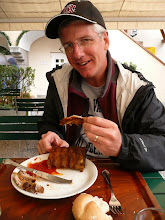 Here we are squished in next to the wall of Disani. We saw stacks of boxes (of water bottles) like this all over Egypt. The Coke salesman must be a busy guy!
Here we are squished in next to the wall of Disani. We saw stacks of boxes (of water bottles) like this all over Egypt. The Coke salesman must be a busy guy!
Quarters were tight on the train. The compartment was quite cozy, with the seats folded out here. The seats and the panel above us swiveled down to turn into the two bunk beds. We had a connecting door between our two compartments, in addition to doors to the hallway. Of course when the doors opened they clanged into each other. This is taken in Jacob and Craig's compartment with the bunk beds in position. The metal ladder collapses and slides under the seats during daytime travel. Even though Nancy and I didn't sleep a wink the night before, we also didn't sleep much if any on the train. There was just too much clackety clack, motion and vibration, and lights flashing through the curtains as we passed little towns. It also didn't help that neither of us figured out how to lay the head end down flat until morning.
This is taken in Jacob and Craig's compartment with the bunk beds in position. The metal ladder collapses and slides under the seats during daytime travel. Even though Nancy and I didn't sleep a wink the night before, we also didn't sleep much if any on the train. There was just too much clackety clack, motion and vibration, and lights flashing through the curtains as we passed little towns. It also didn't help that neither of us figured out how to lay the head end down flat until morning.

 This is taken in Jacob and Craig's compartment with the bunk beds in position. The metal ladder collapses and slides under the seats during daytime travel. Even though Nancy and I didn't sleep a wink the night before, we also didn't sleep much if any on the train. There was just too much clackety clack, motion and vibration, and lights flashing through the curtains as we passed little towns. It also didn't help that neither of us figured out how to lay the head end down flat until morning.
This is taken in Jacob and Craig's compartment with the bunk beds in position. The metal ladder collapses and slides under the seats during daytime travel. Even though Nancy and I didn't sleep a wink the night before, we also didn't sleep much if any on the train. There was just too much clackety clack, motion and vibration, and lights flashing through the curtains as we passed little towns. It also didn't help that neither of us figured out how to lay the head end down flat until morning.
Philae Temple was moved from a low land area to Agelike Island to protect it from the rising waters of the Nile River with the creation of the Aswan High Dam.


As with most major temples, there were several buildings and a large courtyard before you reached the first pylon (outer wall).

Walking through the first pylon, you step into a large courtyard. Back in the day, common Egyptians could step into this area and give their sacrifices to the temple officials.


No comments:
Post a Comment